Athyma ranga (MOORE) - Â÷´³±aß潺 - Blackvein Sergeant
| Distribution | The Butterfly | Number of broods | Food plant | Courtship and Mating | Ovipositing behaviour | Early stages | Acknowledgment | Reference | Plates |
Reprint from FUTAO No.25, 1997 Entomological reports of FUTAO-KAI
688-2, Tashima, Tottori-shi, Tottori, 680-0804 JAPAN / April 11, 1997
A brief note on the life history of Athyma ranga (MOORE) Lepidoptera : Nymphalidae in Hong Kong
James J. YOUNG - 20/F Tung Wai Comm. Bldg., 109-111 Gloucester Road, Wanchai, Hong Kong
Abstract
The general characteristics of the butterfly are described and a summary of its life history is illustrated by colour photographs.
Key Words
Nymphalidae, Athyma ranga, life history, Hong Kong.
Distribution Since described by MOORE in 1858 and who later also erected the genus Kironga for the species, the butterfly is found to cover a wide range from India, Thailand, Malaysia, Indo-China to South China. Four subspecies are recognized.
The Butterfly
Athyma ranga is a medium size butterfly with brownish grey spots on its forewings instead of the usual bands of other butterflies of the same genus. The butterfly is also recognized by its spotted abdomen as well.
The butterfly is seldom found feeding on flowers but is often seen sunning itself in open areas during late autumn. Both sexes resemble each other though the female is comparably larger than the male. Seasonal forms do sometimes exist in particular during the drier months. The adult butterfly is readily seen in the autumn months. This may be due to the reduced level of attack by parasites.
Number of Broods
The adults are generally on the wings from April to December but are more common in September to early December. The butterflies can be found in Kadoorie Farm & Botanic Garden, Tai Mo Shan Country Park, Tai Po Kau Nature Reserve, Shing Mun Reservoir and areas around Pak Sin Range. They are rarely seen on the Hong Kong and Lantau islands. In fact, the sightings are generally from slopes around Tai Mo Shan. They appear to have at least four generations in a year and overwinter in their pupal stage. This paper is based on the result on eggs and larvae collected in Kadoorie Farm and Tai Mo Shan Country Park on the two different food plants recorded and which are reared indoors.
Food plants (Pl.2, figs1,2) Two food plants both from the Oleaceae family are recorded in Kong Kong namely Osmanthus fragrans (LOUR) and Fraxinus retusa (CHAMP) found in Kadoorie Farm and Tai Mo Shan Country Park. Both food plants are not common in Hong Kong. In fact, Fraxinus found in Tai Mo Shan is a tall tree which makes collecting a bit difficult.
Courtship and Mating
No courtship and mating behaviour is observed. Hill-topping is common and one can find male hill-topping in Tai Po Kau Nature Reserve, Kadoorie Farm and hills around Tai Mo Shan.
Ovipositing Behaviour
No ovipositing behaviour is observed in the wild. A single egg is often found on the tip of the upperside of the leaf of the two recorded food plants. In rare occasion, egg(s) is found on the underside of the leaf of the food plants. If found, the only instances are on Osmanthus fragrans (LOUR) and none are found on Fraxinus retusa (CHAMP). Generally, only a couple of eggs are found at a time on the food plants and one can rarely find more than two larvae on the same leaf twig. Perhaps, the butterfly is in fact quite rare.
Early Stages (Pl.2, figs.3-20) Egg : It is similar to that of the Neptini tribe. It is greenish in colour, round with hexagonal pits covered with short hair and flatten on bottom. It is about 1.5mm in diameter. It is laid flat, singly on the tip of the young leaf of the food plants. However, eggs are also found on the more matured leaves of the food plants.
Larva : Caterpillars will emerge in about 3 to 4 days?time from fresh eggs collected in the wild. If the eggs turn blackish, the eggs are parasitized with microflies. The 1st instar is brownish in colour with a round forehead. The dorsal surface of the body has parallel rows of raised patches on each side of the body. The emerging larva will consume the whole of its egg shell and the 1st intar lasts about 5 days. It measures between 3mm to 5mm in length. The larva will consume its skin except its head capsule after each stage of changes.
The 2nd instar takes about 5 days to complete and the raised patches on the dorsal surface of the body have developed into spines. It now measures from 5mm to 7mm. The larva is solitary and feeds along the tip of the leaf of its food plants leaving behind the mid vein of the leaf on which it rests. The edge of the leaf and vein are generally covered with its droppings for camouflage purpose. It tends to stay with the leaf until it has completely finished consuming the whole leaf before moving onto the next leaf.
The 3rd instar lasts another 5 days and now the caterpillar has longer spines on its body and the spines on the pro and mesothorax in particular are more extended. It measures up to 1cm.
The 4th instar lasts about 7 days and the larva measures up to 2cm. Green patches have developed on the surface of the body from the mesothorax to the 3rd abdominal segment. There are long pointers appearing on the forehead and the brown triangular head adfrontals are now more evident.
The 5th or final instar lasts about 12 days and grows to about 3cm in length until it is time for pupation. Various colour changes occur at this stage. It first turns greenish brown in colour with spines all around after molting. A distinctly circular mark in brownish black appears on the 5th abdominal segment on the surface of the body. After a few days, it will then turn into freshly greenish in colour with a striking white band on the 5th abdominal segment. It tends to curve its head inwards when at rest so that to raise the long spines on the pro and mesothorax for arming itself.
Pupa : The larva will pupate on the leaf stalk or on the underside of the midrib of the leaf of its food plants attached by the cremaster at the end of the abdomen. The pupa is odd in shape and is silvery in colour similar to the pupa of Athyma selenophora (KOLLAR). It measures from 2.4cm to 2.5cm. It takes the butterfly about 9 to 19 days to emerge from the pupal stage. It will usually emerge in the morning when there is light. The whole duration from egg to adult takes approximately 41 to 51 days to complete in captivity. Parasitic wasps have been found emerging from pupal cases and are serious parasites for the butterfly.
Acknowledgments
I thank Mr. David YIAU for showing me the food plant found in Tai Mo Shan Country Park and Mr. William Xing Fu-Wu of Kadoorie Farm for identifying the same food plant for me.
References
1) BASCOMBE, M.J. 1995 Checklist of the butterflies of South China ?Memoirs of the Hong Kong Natural History Society.
2) CHOU, I. 1996 Monographia Rhopalocerorum Sinensium. Henan Scientific and Technological Publishing House.
3) CORBET, A. S. & PENDLEBURY, H.M. 1992 The Butterflies of the Malay peninsula. 4th edition revised by J.N.Eliot, Kuala Lumpur.
4) D'BRERA, B. 1985 Butterflies of the Oriental Region Part II. Hill House.
5) Hong Kong Herbarium 1993 Checklist of Hong Kong Plants. Agriculture and Fisheries Department, Bulletin No. 1, 1993.
6) JOHNSTON, G. & B. 1980 This is Hong Kong: Butterflies. Government Printer.
7) THROWER, S.L. 1985 Hong Kong Trees. An Urban Council Publication.
8) PINRATANA, A. & ELIOT, J.N. 1996 Butterflies in Thailand, Vol. Three-Nymphalidae. Bosco Offset, Thailand.
PLATES
The life history of Athyma ranga (MOORE)
|
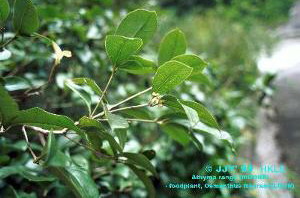
|
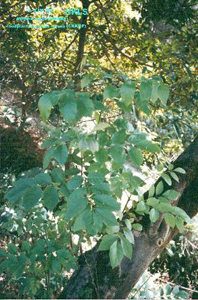
|
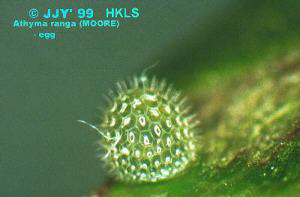
|
| 1) Host plant - leaves and flowers of Osmanthus fragrans (LOUR) |
2) Host plant - leaves of Fraxinus retusa (CHAMP) |
3) Egg-greenish in colour - side view |
|
|
|
|
|
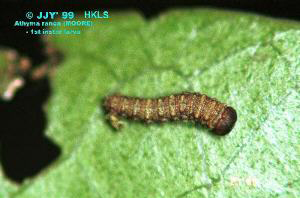
|
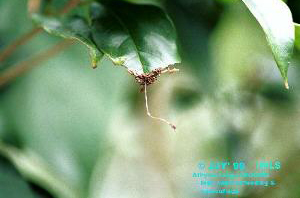
|
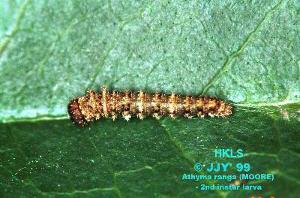 |
| 4) 1st instar larva -dorsal view |
5) 2nd instar larva- top and side view |
6) Leaf-habit of feeding and camourflage |
|
|
|
|
|
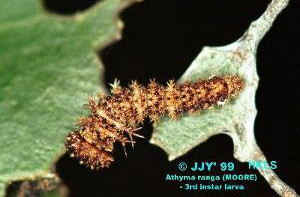
|
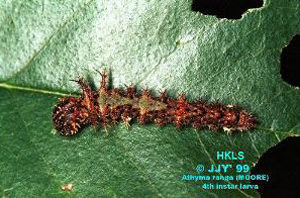
|
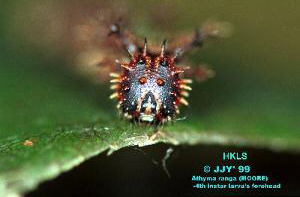
|
| 7) 3rd instar larva - top view |
8) 4th instar larva - top view |
9) 4th instar larva - forehead |
|
|
|
|
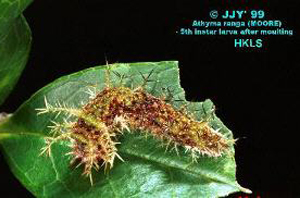
|
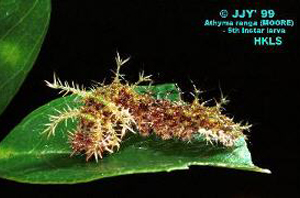
|
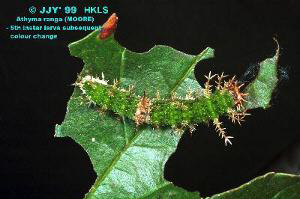
|
| 10) 5th instar larva - top view- change after moulting |
11) 5th instar larva - top view- change after moulting |
12) 5th instar larva - subsequent colour change |
|
|
|
|
|
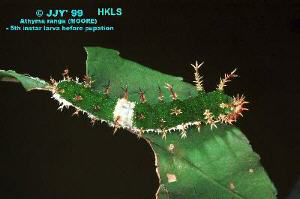
|
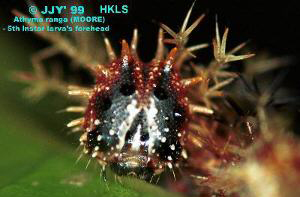
|
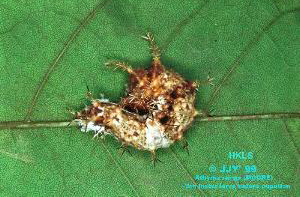 |
| 13) 5th instar larva - before pupation |
14) 5th instar larva - forehead |
15) 5th instar larva - before pupation |
|
|
|
|
|

|
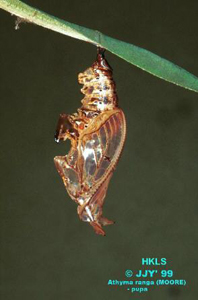
|
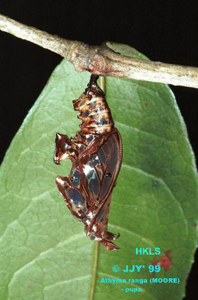
|
| 16) 5th instar larva - before pupation |
17) Pupa - side view on Fraxinus retusa (CHAMP) |
18) Pupa - side view on Osmanthus fragrans (LOUR) |
|
|
|
|
|
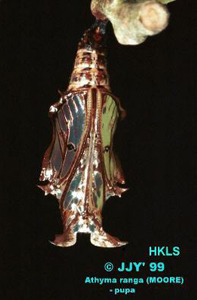
|
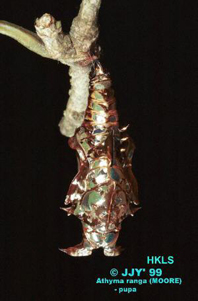
|
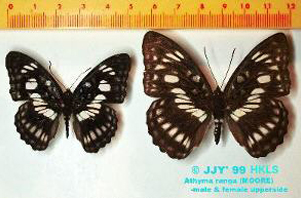 |
| 19) Pupa - front view |
20) Pupa - back view |
21) Adult-female in open space - 8/12/1995 Shing Mun Reservoir |
|
|
|
|
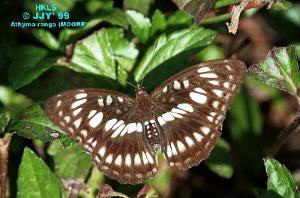 |
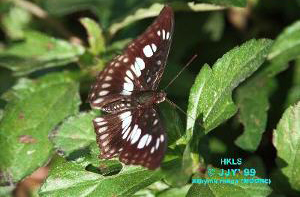 |
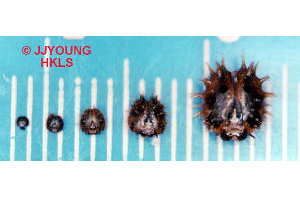
|
| 22) Adult-male in open space - 16/12/1995 Shing Mun Reservoir |
23) male and female - upperside |
24) Head capsules of all instars (N.B. scale - one space = 1mm) |
(Prepared by J.J. Young)
This page was created on 14th December, 2000.
©2004 Hong Kong Lepidopterists' Society Limited
|